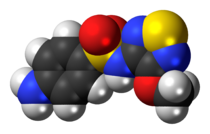
Trimethoprim (TMP) is an antibiotic used mainly in the treatment of bladder infections. Other uses include for middle ear infections and travelers' diarrhea. With sulfamethoxazole or dapsone it may be used for Pneumocystis pneumonia in people with HIV/AIDS. It is taken orally.
ATC code J01Antibacterials for systemic use is a therapeutic subgroup of the Anatomical Therapeutic Chemical Classification System, a system of alphanumeric codes developed by the World Health Organization (WHO) for the classification of drugs and other medical products. Subgroup J01 is part of the anatomical group J Antiinfectives for systemic use.

Trimethoprim/sulfamethoxazole, sold under the brand name Bactrim among others, is a fixed-dose combination antibiotic medication used to treat a variety of bacterial infections. It consists of one part trimethoprim to five parts sulfamethoxazole. It is used to treat urinary tract infections, methicillin-resistant Staphylococcus aureus (MRSA) skin infections, travelers' diarrhea, respiratory tract infections, and cholera, among others. It is used both to treat and prevent pneumocystis pneumonia and toxoplasmosis in people with HIV/AIDS and other causes of immunosuppression. It can be given orally or intravenous infusion.

Folinic acid, also known as leucovorin, is a medication used to decrease the toxic effects of methotrexate and pyrimethamine. It is also used in combination with 5-fluorouracil to treat colorectal cancer and pancreatic cancer, may be used to treat folate deficiency that results in anemia, and methanol poisoning. It is taken by mouth, injection into a muscle, or injection into a vein.

Sulfamethoxazole is an antibiotic. It is used for bacterial infections such as urinary tract infections, bronchitis, and prostatitis and is effective against both gram negative and positive bacteria such as Escherichia coli and Listeria monocytogenes.

Burkholderia is a genus of Pseudomonadota whose pathogenic members include the Burkholderia cepacia complex, which attacks humans and Burkholderia mallei, responsible for glanders, a disease that occurs mostly in horses and related animals; Burkholderia pseudomallei, causative agent of melioidosis; and Burkholderia cepacia, an important pathogen of pulmonary infections in people with cystic fibrosis (CF). Burkholderia species is also found in marine environments. S.I. Paul et al. (2021) isolated and characterized Burkholderia cepacia from marine sponges of the Saint Martin's Island of the Bay of Bengal, Bangladesh.

Moraxella catarrhalis is a fastidious, nonmotile, Gram-negative, aerobic, oxidase-positive diplococcus that can cause infections of the respiratory system, middle ear, eye, central nervous system, and joints of humans. It causes the infection of the host cell by sticking to the host cell using trimeric autotransporter adhesins.

Dihydropteroate is an important intermediate in folate biosynthesis. It is a pterin created from para-aminobenzoic acid (PABA) by the enzyme dihydropteroate synthase.

Sulfadimidine or sulfamethazine is a sulfonamide antibacterial.

Brodimoprim is a structural derivative of trimethoprim. In brodimoprim, the 4-methoxy group of trimethoprim is replaced with a bromine atom.

Antifolates are a class of antimetabolite medications that antagonise (that is, block) the actions of folic acid (vitamin B9). Folic acid's primary function in the body is as a cofactor to various methyltransferases involved in serine, methionine, thymidine and purine biosynthesis. Consequently, antifolates inhibit cell division, DNA/RNA synthesis and repair and protein synthesis. Some such as proguanil, pyrimethamine and trimethoprim selectively inhibit folate's actions in microbial organisms such as bacteria, protozoa and fungi. The majority of antifolates work by inhibiting dihydrofolate reductase (DHFR).

Tetroxoprim (INN) is a derivative of trimethoprim. It was first described in 1979.

Fixed drug reactions are common and so named because they recur at the same site with each exposure to a particular medication. Medications inducing fixed drug eruptions are usually those taken intermittently.
ATCvet code QJ51Antibacterials for intramammary use is a therapeutic subgroup of the Anatomical Therapeutic Chemical Classification System for veterinary medicinal products, a system of alphanumeric codes developed by the World Health Organization (WHO) for the classification of drugs and other medical products for veterinary use. Subgroup QJ51 is part of the anatomical group QJ Antiinfectives for systemic use.
Trimethoprim/sulfadoxine, sold under the brand name Trimidox, is an antibacterial agent that is used in cattle and swine to prevent and treat infections by both gram-negative and gram-positive bacteria.

The NYC medium or GC medium agar is used for isolating Gonococci.

Wellcome Research Laboratories was a site in Beckenham, south-east London, that was a main research centre for pharmaceuticals. Until 1965, this laboratory site was situated in Kent.
Isoniazid/pyridoxine/sulfamethoxazole/trimethoprim (INH/B6/CTX) is a fixed-dose combination medication for the prevention of opportunistic infections in HIV/AIDS. It combines isoniazid, pyridoxine, sulfamethoxazole, and trimethoprim. Specifically it is used to prevent tuberculosis, toxoplasmosis, pneumonia, malaria, and isosporiasis. It is taken by mouth.
Trimethoprim/sulfadiazine (TMP/SDZ) is a combination drug composed of trimethoprim and sulfadiazine used in the treatment of bacterial infections of animals, particularly horses.















